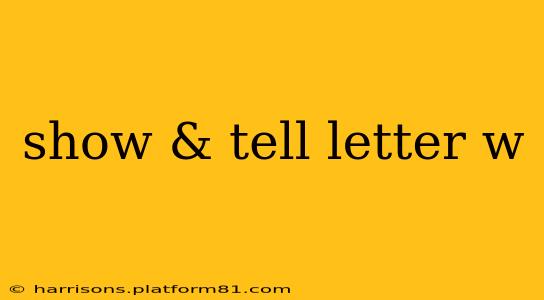Learning the alphabet can be a blast! This guide provides creative and engaging ways to teach the letter W, making it a memorable experience for preschool and kindergarten children. We'll explore various activities focusing on the letter W's shape, sound, and real-world examples, transforming learning into an interactive adventure.
What Does the Letter W Look Like? Exploring the Shape of "W"
The letter W can be tricky for little ones. It's not as simple as a straight line or a circle. So, how do we make learning the shape fun and engaging?
- W is for Wobbly: Start by explaining that W looks a bit like two V's joined together. Think of it as two wobbly lines leaning into each other! Use your hands to show the shape in the air, mimicking the wobbly motion.
- W is for Weaving: Use yarn or string and have kids weave it back and forth to create a W pattern. This tactile activity reinforces the shape in a fun way.
- W is for Writing: Practice writing the letter W in different mediums. Try finger painting, using large crayons on paper, or even writing it in sand or shaving cream for sensory exploration.
What Sounds Does W Make? Mastering the "W" Sound
Next, we focus on the letter W’s sound. This seemingly simple step is crucial for phonetic development.
- W is for Words: Start by saying words beginning with "W" and having children repeat them. Some examples are: water, whale, wagon, and watermelon. Use visual aids like flashcards or pictures to associate the word with the letter.
- W is for Wonderful Sounds: Make it playful! Try whispering "W" sounds. What kind of words can we whisper? Encourage them to associate the softness of the sound with the letter.
- W is for Word Search: Create a simple word search puzzle with words starting with "W." This reinforces both the sound and the visual recognition of the letter.
How can I teach my child the letter W?
This question highlights a parent's desire for practical teaching methods. The above activities offer a multi-sensory approach that caters to different learning styles. Combining visual, auditory, and kinesthetic elements ensures maximum retention. Remember to keep it fun, rewarding effort, and adapting the activities based on your child's individual needs and preferences.
What are some things that start with the letter W?
This question addresses the crucial aspect of real-world application.
To answer, focus on things children encounter daily. Examples include:
- Water: Show them a glass of water, play with water in a tub, or even watch rain falling.
- Wheels: Use toy cars or a real-life bicycle to point out the wheels.
- Watch: Explain the concept of time and the function of a watch (perhaps using a large, easy-to-read one).
- Wall: Point to the walls of the room, emphasizing their function.
Connecting the letter to tangible objects reinforces understanding and helps solidify the connection between letter and meaning.
What are some fun activities to teach the letter W?
This question focuses on the interactive element.
Beyond the activities already mentioned, consider:
- W is for Watermelon: Cut open a watermelon and enjoy it together while discussing the letter. This connects letter recognition with a fun, delicious experience.
- W is for Wiggle: Encourage wiggling and waving to demonstrate the movement associated with the letter's shape.
- W is for Wonderful World: Explore different objects starting with "W" through interactive books and games.
Remember, learning is a journey, not a race. Celebrate your child's successes and continue to engage them in fun, creative ways. The more enjoyable the learning experience, the greater the retention and overall enthusiasm for literacy!
